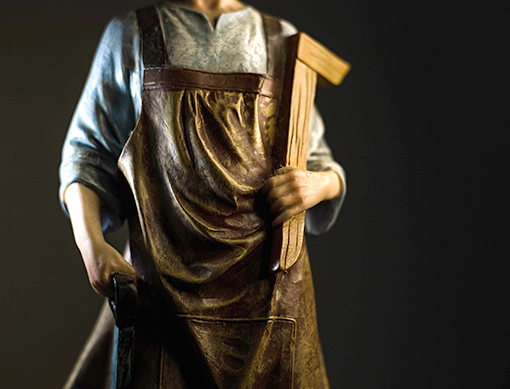There’s a lot to be said about imagining. It’s a regular pastime of children, and a wonderful tool for teaching. It’s also at the heart of all creative endeavors. Can you imagine a world where there is no imagination?
 Since March is also the month dedicated to St. Joseph, it presents a wonderful opportunity to do some imagining about the earthly father of Jesus, so important in the life of the Son of God, but from whom there is not a word inscribed in Scripture.
Since March is also the month dedicated to St. Joseph, it presents a wonderful opportunity to do some imagining about the earthly father of Jesus, so important in the life of the Son of God, but from whom there is not a word inscribed in Scripture.
St. Joseph is mentioned in the Nativity stories in the Gospels of Matthew and Luke, once in the Gospel of John when someone refers to Jesus as the “son of Joseph,” and no where else in Scripture, even in the Gospel Mark.
What we do know about St. Joseph from Scripture is very limited, and what we’ve heard about St. Joseph, like his age or when or how he died, comes from oral and written tradition, often from ancient documents that were not part of the books of Scripture.
So, what do we actually know from Scripture?
Joseph was a carpenter, or, in the original Greek of the Scriptures, a “tekton,” a person skilled in using materials of all kinds. Jesus was known as the carpenter’s son. Neighbors were probably familiar with father and son working together, not only in their shop, but making repairs or doing first century remodeling on local homes or businesses.
Joseph was the spouse of Mary and foster father of Jesus. His family depended on him. He passed on values, traditions, and his Jewish faith. They went on pilgrimage together to the Temple in Jerusalem where they lost Jesus for a few days. As any good father would, he went back to look for him with Mary. No doubt there were other times when Joseph had to intervene in some adventure of Jesus, as a child or as a teenager.
Joseph listened and was obedient to God. Joseph is sometimes referred to as the man of dreams because it was through angels speaking to him in dreams that God communicated his plans to Joseph. Three of those times included when an angel of the Lord tells him to take Mary as his wife and name the child Jesus; to flee by night into Egypt with Mary and Jesus, to return to Israel with his family, and to move to Galilee where he establishes his home in Nazareth.
A Day in the Life of St. Joseph: An exercise in imagining
Using both your curriculum guides and Bibles, help your students come to know Joseph a little bit better, at least as more than a statue with a staff standing in the Nativity scene. Then encourage them to write or draw a day in the life of St. Joseph as they imagine it might have been. They might need help with a little imagery of the environment the Holy Family lived in. Some of it might be in student texts, but some library research would held engage the students in creating their literary or artistic masterpiece.
For teachers: Check out Pope Francis’ 2021 Catechesis 1 on St. Joseph – St. Joseph and the environment in which he lived. It includes what he calls a “home-made prayer” to St. Joseph, that comes from the heart:
Saint Joseph,
you who have always trusted God,
and have made your choices
guided by his providence
teach us not to count so much on our own plans
but on his plan of love.
You who come from the peripheries
help us to convert our gaze
and to prefer what the world discards and marginalises.
Comfort those who feel alone
and support those who work silently
to defend life and human dignity.
Amen.
 About the Author
About the AuthorMary Clifford Morrell, mother of six and grandmother to ten, is a Catholic journalist, editor, and author who has served the Dioceses of Metuchen and Trenton, New Jersey; Burlington, Vermont, and RENEW International in the areas of religious education and communication.
